pifpaf
New member
1963. A pivotal year in horology history. It is the year that undoubtedly marks the last great epoch of the “utilitarian” mechanical horology. At this time is created the legendary chronograph Heuer Carrera.
Jack Heuer transcends the Helvetic neo-classicism of the 50s to introduce functionalism into the chronograph. The reason behind this decision? Mechanical sports.
The connivances between mechanical sports and Tag Heuer are old and intimately linked to the La Chaux-de-Fonds’ brand history. This adventure began before the Great War. In 1963, Tag had already been manufacturing pocket watches dedicated to sports timing for more than fifty years. For instance, the “Mikrographe” vintage was manufactured at the start of the 20th Century or, some years before the Carrera, the “Rally Master”, a dashboard chronograph.
As an opposition to what the neophyte may presume, the Carrera name is not linked to Porsche; it was rather inspired by the mythical race of the 50s, the Carrera Panamericana AKA “Pan Am”. What can be seen as an astonishing paradox is that before 1963, this event had not occurred since 1955, following a decision of Mexican authorities. This interruption was the result of the psychological trauma caused by the tragic accident of the Mercedes 300 SLR at the 24H of the Mans 1955… However, Jack Heuer turned out to be a visionary by betting on the resurrection of this anthology race... The event is back on track since 1988.
It is this vision, this intuition, this understanding which are the forging factors of the Carrera history…
Heuer Carrera 45 Dato "Cobra Shelby" 3147
Likely to be seen as something minor nowadays, one was aware that even the most minor detail was relevant in performance research at the time.
Heuer applied the solutions giving a maximum readability to military watches of the interwar period to sports watches: greater aperture and black dial for a maximum of contrast.
The first reference of the Carrera is the 2447. Bicompax, panda or full black, it is a round watch of 36mm (which was relatively big for the time). Animated by a Valjoux 72, a standard movement during the after-war; its frequency is at 18000 vph for 45 hours of power reserve.
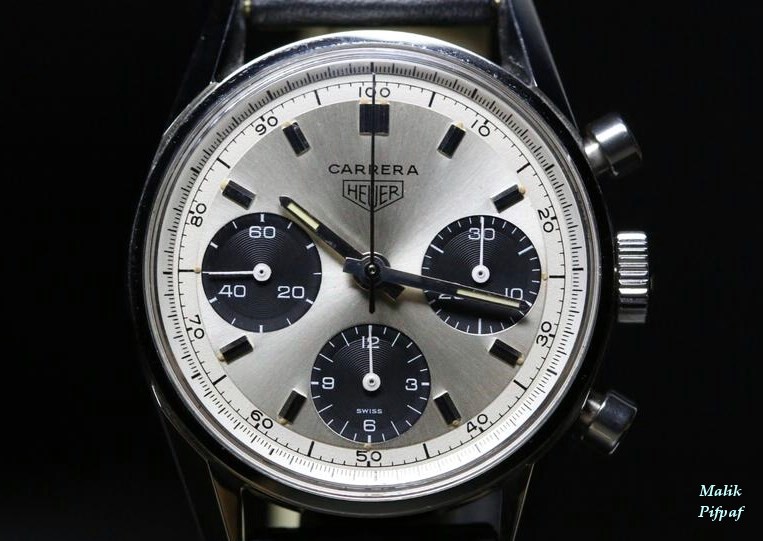
It presents numerous similarities with the Rolex “Pré-Daytona” ref. 6238: the calibre, the dial and the push-pieces. What is even better is that the future 6239, just like the Carrera, will adopt the name of an automobile event across the Atlantic: Daytona.
However, even if the Daytona and the Carrera started off at almost the same point (in the 60s, the products were less “identity-oriented” than today) and were presented in the same year (the Daytona also celebrates its 50 years this year), they had diametrically opposed destinies.
On the one hand, the Daytona evolved very little, as much in terms of motorization as aesthetics, since Rolex privileged reliability and durability above all.
On the other hand, the Carrera became a permanent, aesthetic and technical laboratory.
Here, we have to make reference to the Heuer Carrera 45 Dato « Cobra Shelby » 3147. In fact, in 1963, it was rare to have “branded” watches (the 70s and 80s were the Golden Age of the “branded” watches).
It is thus due to the logo of the British constructor that the 3147 will be of more interest to us than the 2447.
Despite the legitimacy and the explosive potential of a partnership between the AC Cobra and Tag Heuer niche constructor, the Dato 45 was not a commercial watch.
In the 60s, Carol Shelby, ex-racing driver (he won the 24h du Mans in 1959 Mans with Aston Martin), decided to create the American racing car; he turned to Ford, which was able to supply the motor and the money and was helped by AC, a British constructor which owned the European know-how in terms of chassis.

The AC Cobra was born; it would know a qualified success: sales during the 60s did not exceed 1000 copies, divided into diverse versions.
The car is too early and too pointed, it precedes the Muscle Cars era; however, the latter will aim higher in the objective set by the Cobra Shelby: be as powerful as the GTs of the moment for much less money.
Shelby had opted for a compromise between the dynamic qualities of the automobile and its cost. The Muscle Cars would be much more radical, leaving behind all equilibrium in terms of behavior, in favor of atmospherics V8s under steroids, at dumped prices…
To motivate sales forces, the Ford group asked Jack Heuer to manufacture its Dato 45, declined into two series : the first (1966-67), Bicompax and the second (1968-69) more radical, Monocompax, the latter consisting of the AC Cobra initials.
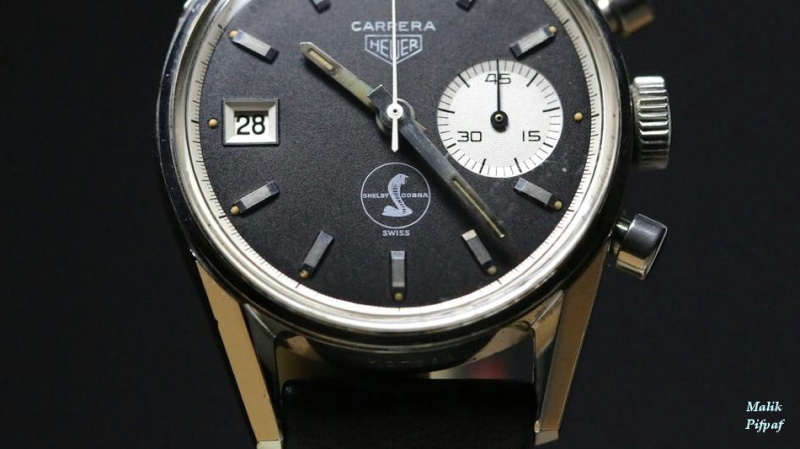
It is obviously this version which will be of interest here since it prefigures various heavy trends through its aesthetics. First and foremost, the automobile/horology partners which are henceforth the forgotten passage of any large-scale watchmaking firm.
The dial is decorated with an automobile brand’s logo (a first?!) And what a logo! AC’s Cobra is incredibly aggressive and perfectly corresponds to Shelby’s sports vocation: combine the best of European and American automobile.
Then, the watch proposes a big date and a big white timer of graduated minutes up to 45. Obviously, everything is done in the scope of a maximum readability: with its great aperture at the dial, the watch cuts more than the announced 36mm.
The case is the embodiment of simplicity; its horns are very long which is logical given its size. Besides, the current Carreras will conserve this characteristic but with a greater-sized case.
Furthermore, the watch is motored by an unusual caliber (in the Carreras only; it was relatively common at the time) of manual chronograph: the Landeron 189, 31mm in diameter for 6.85mm in width. It has a frequency of 18000 vibrations per hour for 42 hours of power reserve.

It is to be noted that the steel case resonates quite a lot and that the sound characteristic of 2.5Hz is quite audible for such a small watch.
If the Heuer Carrera 45 Dato “Cobra Shelby” is almost impossible to find by chance, you may find a 45 Dato without logo for approximately 3’500 CHF…
Which is much less expensive than an original Cobra Shelby, because let’s admit it, it is much more simple (and economic!) to wear a vintage watch than to drive an appropriate car.
Heuer Skipper 7754 « Skipperera »
Another model which is slightly off-beat but very much iconic of the creative medium that defines this series is the Skipperera. The Skippers are a bit difficult to classify in the Heuer lines, as they are sometimes Autavia and sometimes Carrera. Experts air varying opinions about it…
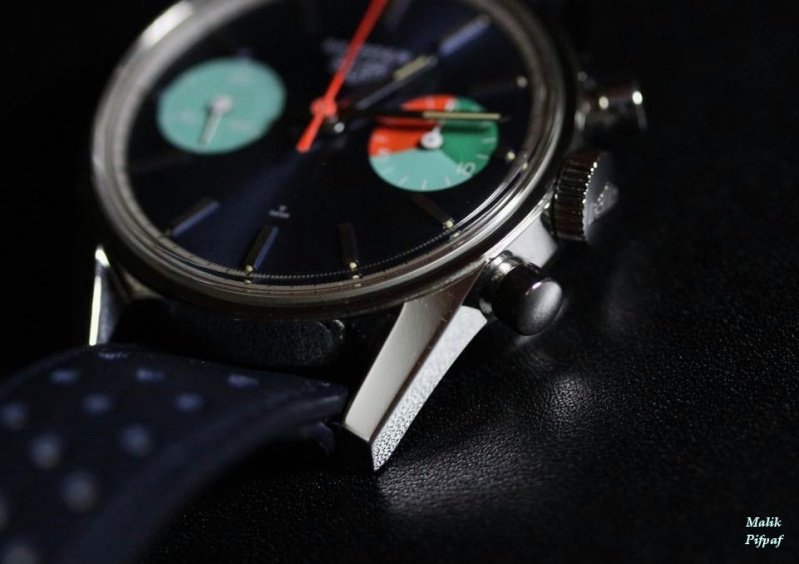
As far as the aptly named “Skiperrera” presents a Carrera case, one can consider that it is a full Carrera.
The interest of this watch lies in its aesthetics. It neither distinguishes itself by its case, which is the standard version of the Carreras, neither by its calibre, a Valjoux 7730.
However, before focusing on the dial, it is useful to linger on this calibre a bit. The Valjoux 7730 is a calibre of manual chronograph having a frequency of 18000 vibrations per hour for 45 hours of power reserve, it measures 31mm on 6, that is, almost the same dimensions as the Landeron 189.
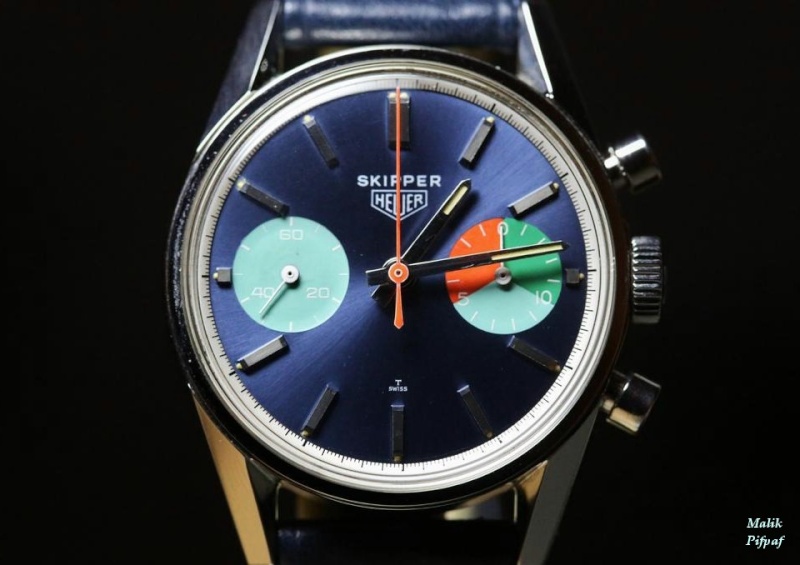
One will note that at the time, the size ratio of the caliber/size of the case was different from that of today. Back then, like sports cars’ motors, big calibers were cased up in small cases, at shoehorn.
What makes the particularity of this 7730 (which is probably the reason for his choosing this Skipper) is that it offered the possibility to display 30 or 45 minutes on the sub-dial at the 3 o’clock position. And here, Heuer had driven this function into a corner: by modifying a wheel, it was possible to display only 15 minutes by thirty jumps of thirty seconds.
Why is that? The answer is, as always, that it was for this famous countdown of the regatta launching. One will equally note that the minutes’ timer is graduated in the inverted direction: it is launched 15 minutes before the regattas start, the last third indicating the “warm-up” of the event.

However, the main interest of the watch does not concern the above but rather the dial, which is one of the most beautiful that I have ever held. The dials from that epoch are of a great quality and are no less appealing than the current productions. The reliefs are qualitative, the textures very clean and above all they grow old in a very good way, of which the good quality of the epoch’s lacquer is proof.
The colour scheme of this Carrera 7754 is perfect: night blue, almond green, orange, in ideal proportions. In a visionary way, it synthesises everything that was best made in sports and summer dials of the next 40 years. Night blue for looking good, orange for relaxation and almond green for nostalgia.
Moreover, the very streamlined context of the Carrera (white railroad, index and simple hands) further highlights the colour scheme.
The collectors are not wrong; it is approximately quoted the double of a Carrera from that time, often as from 7’000 CHF.
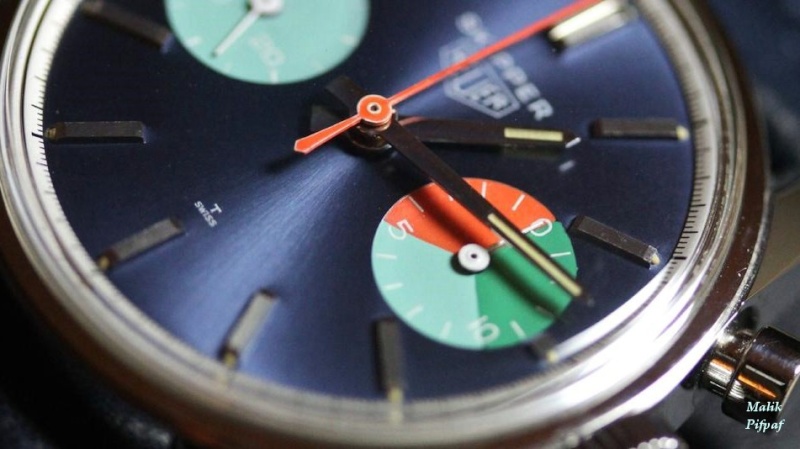
Heuer Carrera « Automatic 70’ » 110.253, Côte de Genève
Directly moving on to the year 1978, we will interest ourselves with the Heuer Carrera 110.253 since the latter joins numerous emblematic elements of the 70s’ Carrera.
The first major change was the case: it became barrel, was enlarged by 2mm and lost its long horns, very characteristic of the 70s. For the purists, it is undoubtedly slightly shocking; so much as this model distanced itself from the 60s’ models. However, in opposition to a Daytona, which is monolithic by vocation, it is a laboratory; it is thus legitimate that its creators attempted to change the shape of its case.
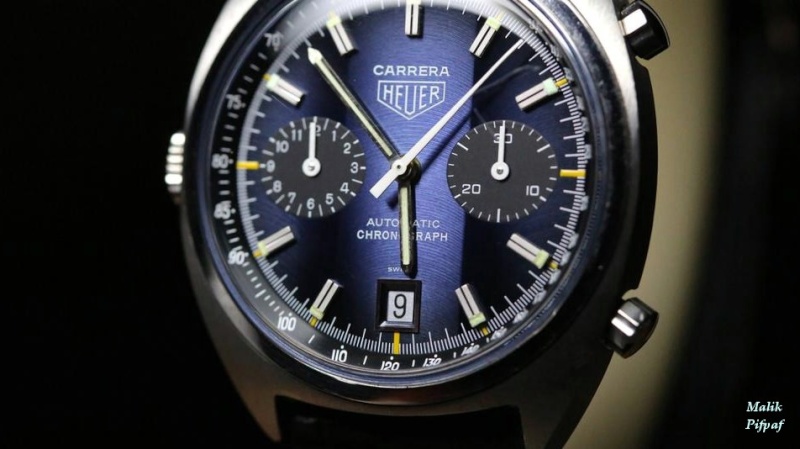
From a personal point of view, I prefer the 60s’ case due to the fact that its streamlining seems completely achieved to me. Here, the case is very sympathetic, very funky but slightly clumsier than the one from the 60s. While the 60s’ case was the avatar of Jack Heuer’s modernism passion, the 70s’ case ensued from a simplification wish of a case already very streamlined, of postmodernism all in all… Consequently, the case called “automatic 70’” has two advantages: its more solid horns and its superior diameter; as a result, these Carreras seem much bigger on the wrist than their predecessors.
It seems that Tag Heuer has made the same choice for its contemporary watches, in preserving the 60s’ case shape (this will further be developed at the end of the article).
If the case has been named «Automatic 70’», it must be known that a good deal of the watches it equips are manual!
In fact, the 70s are the time at which automatic chronographs appeared right in the middle of the quartz crisis… Between financial and suppliers problems, reliability issues of the automatic chronographs, a great deal of the Carreras from the 70s were equipped with manual movement.
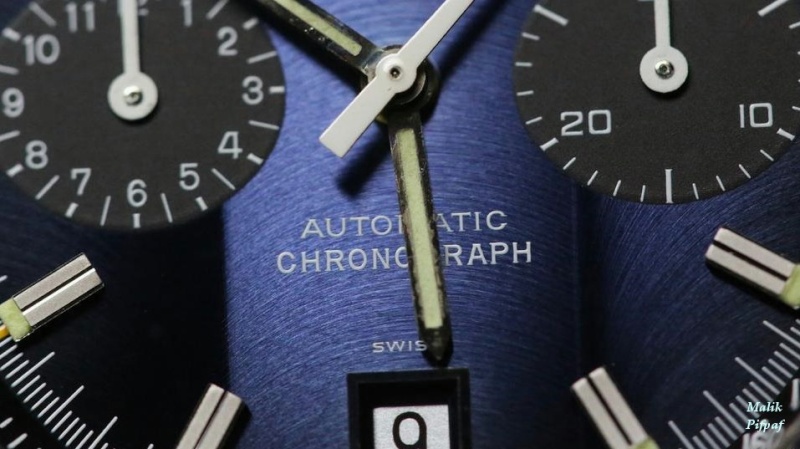
However, this is not the case for this 110.253, which is equipped with a variant of the legendary Heuer Buren Calibre 11: the vintage calibre 12.
The calibre 12 is thus an automatic chronograph with 21600 vibrations per hour, contrary to the vintage calibre 11, with an intermediary frequency of 19800 vibrations per hour. The caliber has a 42-hour power reserve and measures 31mm for 7.7 in width.
It has been nicknamed «Chronomatic» and the oscillating mass will not be visible on the photos: which is normal since it has been hidden by the chronograph’s mechanism.
Like the Calibre 11, the vintage calibre 12 is a Buren 1281 with a Dubois Depraz 8510 chronograph module.
Nevertheless, if it is more classic in its frequency, it is also more legitimate: a six jumps per seconds basis is the most legitimate in a sexagesimal time system.

Last detail, the crown has been fitted at the 9 o’clock position but the push-buttons (less protruding than that of the 60s’ models, alas) are in their usual position, namely at the right of the case. The contrary might have been more ergonomic, it seems more instinctive to activate a chronograph with the right hand’s thumb rather than with the index…
On the dial’s side, like the other vintage Carreras, it is sportive classicism with a touch of madness, the whole served by an execution level which is no less appealing than the most beautiful current productions.
Proof of this? The dial is crossed by three big blue Côtes de Genève, very well made, the black sub counters almost break its harmony. In fact, the latters are flat and matt with white indexes. However, despite the beauty of its dial, this Carrera 110.253 is a tool watch, thus the functional aspect prevails.
Besides, the whole of the index/hands remains very classic, polished steel, streamlined design. Priority is given to efficiency.
It is not very hard to find one at approximately 2’500 CHF, which isn’t much if the dial’s execution quality and the embedded legendary movement are taken into consideration.
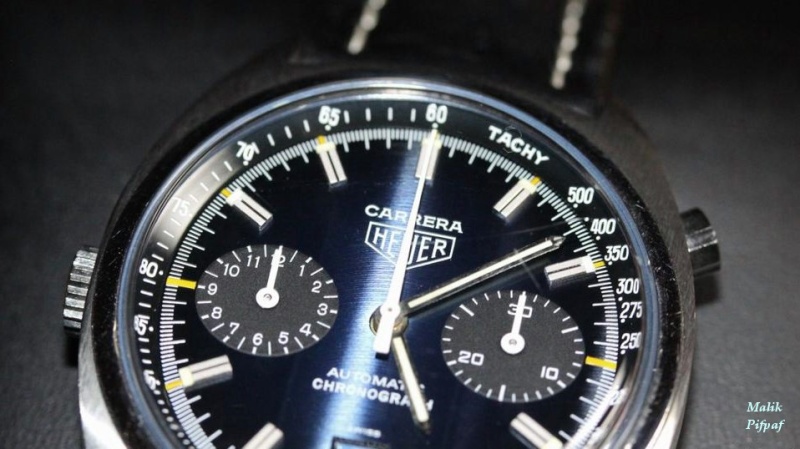
Heuer Carrera « Automatic » 510.511, military aviation.
Just like the Skipperera, the 510.511 is a rarity, outside the Carrera series. So why is this piece being described?
Contrary to the Skipperera, it is not the most beautiful of the Carreras, but its technical interest is enormous.
As an introduction, it is worth knowing that this watch has a false twin, the 510.513, identical with a dial presenting blue Côtes de Genève arranged horizontally. Unfortunately, this piece was not available at the Tag Heuer museum where the photos of this reporting have been taken.

The watch exists in two versions: one in steel (ref 510.523), and one in PVD steel, this latter finish reinforcing its military aspect. The case takes up the design of the « Automatics 70’ » (even if the watch dates from 1984), but it is slightly bigger, with 40mm in diameter. The watch is water resistant to 100 meters and the push-pieces are of the right size.
This watch’s interest resides in its caliber: back then, Lemania was not in the Swatch Group circle (Lemania’s industrial tool served to build the Breguet firm) and produced numerous watches and calibers to the destination of armed forces.
Thus, the legendary Lemania 5100 which equips this Carrera 510.511 is an automatic chronograph mechanism of second generation intended for military aviation, including fighter pilots. It is why this movement presents an extraordinary resistance to the accelerating forces (11G) and to strong decelerations (7G).
It may be used for several years without service and is exceptionally robust. Its construction is unusual, the movement is structured around pillars, like a building and has some nylon pieces (which was trendy at the time…)
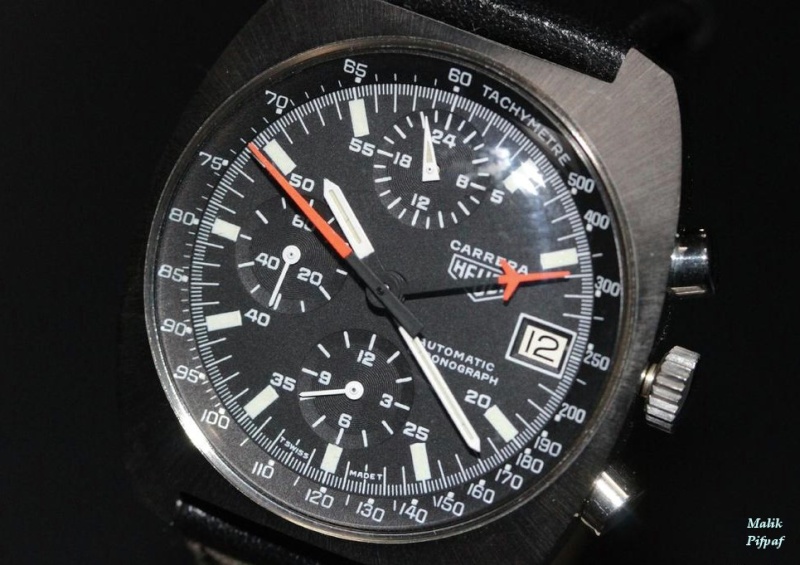
It has a frequency of 28800 vibrations per hour for 48 hours of power reserve and measures 31mm for 8.2, thus slightly bigger than a 7750.
Many wrote that it is not very beautiful. It is certainly not the incarnation of sex-appeal, but apart from the El Primero (Calibre 36 at Tag Heuer), the automatic chronographs’ movements from the years 70-80 were much less beautiful than the manual chronographs’ calibers of the after-war.
Moreover, this movement has several functions. The most noteworthy and playful is the central minutes’ timer, materialized by the aeroplane-shaped orange hand. The watch has four hands which pass through the central cannon: hour, minute, chrono second and chrono minute.
In addition to the 60 seconds and minutes at the center, the chronograph indicates the twelve hours cumulated at the 6 o’clock position, the 24h time at the 12 o’clock position, the small second at the 9 o’clock position and finally the date at the 3 o’clock position. Even if it is relatively charged, it is no less readable.
A relatively rare and totally mythical watch, which can be found at approximately 3’500 CHF, which is completely correct given the product’s quality. I cannot advise strongly enough the 510.513 if you bear it an interest, less military-aviation in its look and more Funky-Carrera.
Tag Heuer Carrera Calibre 36 ref: CAR2B11.BA0799
Beware, we are focusing on BaselWorld 2013 without transition since the Carrera series still exists and innovation remains present in this mythical model’s 50th anniversary year. You will find that at each generation, the references become more complex… By making an almost 30-year jump (including a long ten-year interruption, from the mid-80s to 1996), the 6-number reference has been transformed into this type of reference: CAR2B11.BA0799. Phew.
Before getting into the details of this Calibre 36, which particularly seduced me, two other models deserve a special mention on the occasion of this anniversary year.
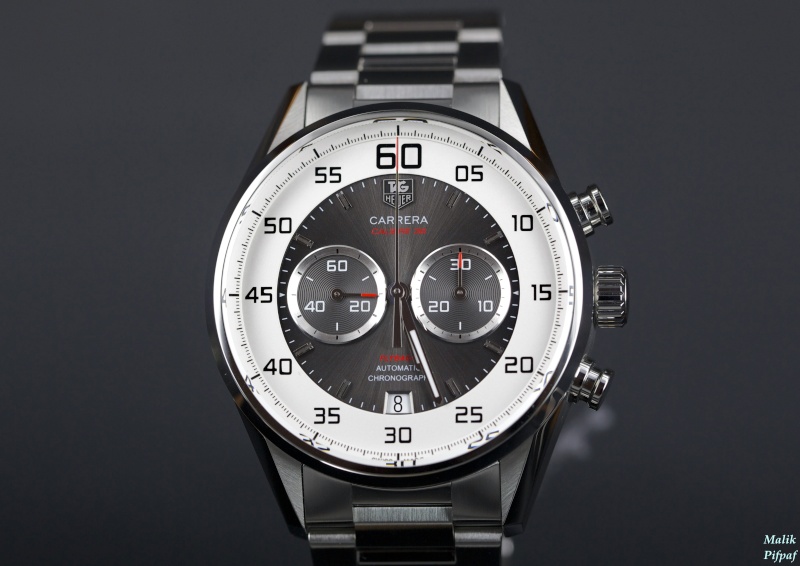
It is thus obviously, the anniversary model, the Jack Heuer Carrera declined into two versions, which correspond to two founding decades of the Carrera series.
The first model is thus the Jack Heuer Calibre 17, 80th anniversary (Jack Heuer’s) which is the direct descendant of the 2446 evoked at the start of this article, 41mmsteel, Calibre 17, it even takes up the panda dial! Consequently, it virtually resembles the first Carrera, in a more modern format. Perennially fashionable, efficient.
The second model is the Jack Heuer calibre 1887, in the Bull-head format! This layout results from a 90° rotation, where the push-pieces are at the 11 and 1 o’clock positions and the crown at the 12 o’clock position.
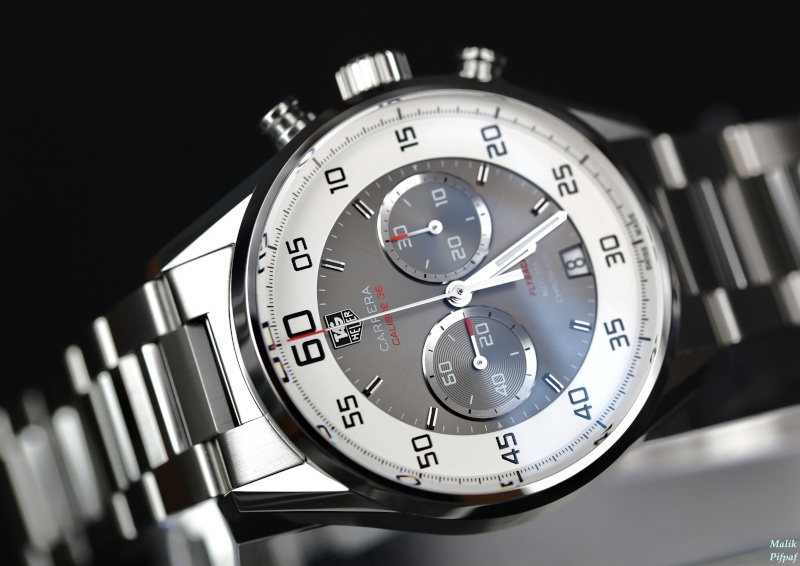
It is the most emblematic chronograph configuration of the 70s, directly inspired from the Stopwatches (Heuer in particular) buttons’ layout, typical of Olympic stadiums as well as 70s’ EPS courses!
Surprisingly, against all expectations, there was no Heuer Carrera with this type of configuration at the time. It almost seems like Heuer wants to make up for this oversight by introducing such an emblematic watch. The case measures 45mm in diameter, it is in steel and DLC titanium at the level of the bezel, and is equipped with the calibre 1887. This watch deserves a long review, so that its historical, technical and cultural aspects may be examined…
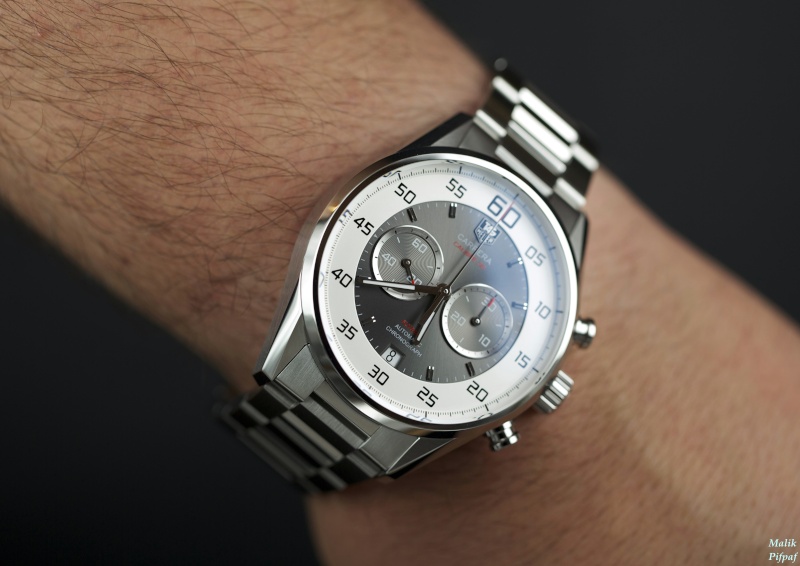
Back to the Calibre 36, it is equipped with a bi-coloured dial and this watch is exciting at several levels. It is a synthetic watch of the trends which have passed at Tag.
Before embarking upon the analysis of its aesthetics, the focus needs to be put on its motor. The watch is equipped with a Calibre 36, that is, a Zenith El Primero modified for Tag Heuer.
Today, Zenith and Tag Heuer work together in the midst of the LMVH group. However, this has not always been the case: at the end of the 60s, these brands had launched themselves in a technological course, to know which would first introduce an automatic chronograph.
Without any suspense, with its longevity as proof, the El Primero hit two birds with one stone: on the one hand, it had been introduced some weeks before the 1969 Calibre 11; but it had above all turned out to be a better solution in terms of frequency, reliability and even aesthetics: it was the most beautiful automatic chronograph caliber from that time.
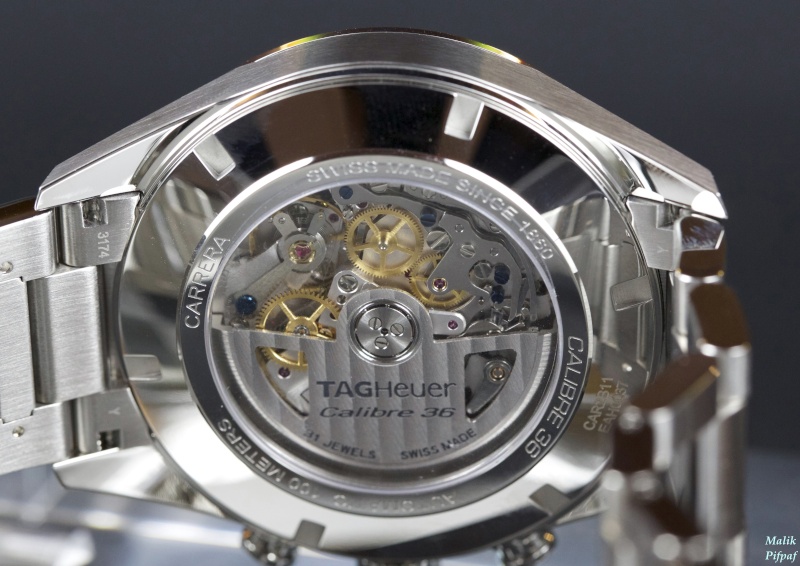
No one is perfect, the central timers are too close to one another and due to its high frequency the power reserve is often slightly short according to the type of barrel spring that the EP embeds…
In this recent version, Tag Heuer has nevertheless done the necessary modification work: the 36-hour power reserve has been increased to 50 hours, which is sufficient to set the watch down for the week-end. As a reminder, the EP/Calibre 36 is rhymed at 5Hz/36000 vibrations per hour, measures 30mm in diameter and is fitted with 31 rubies.
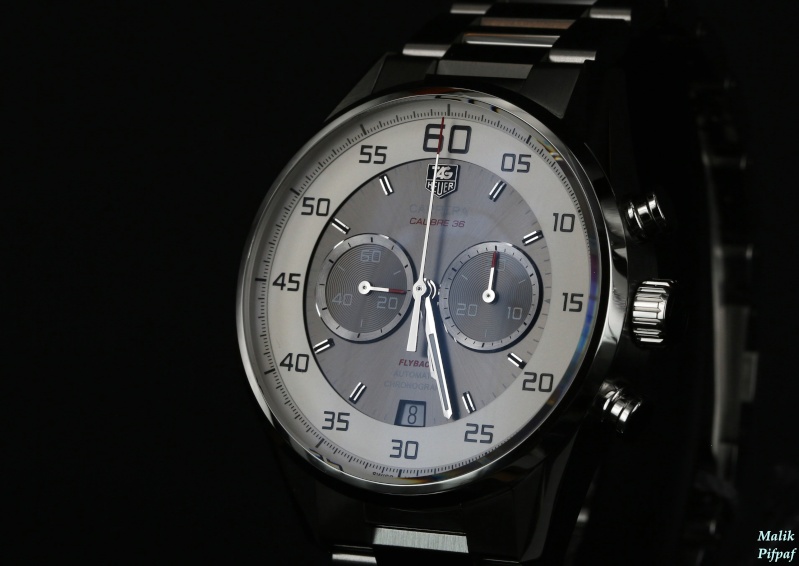
Likewise, a trick has been employed to propose an aesthetic giving sense to the too close sub-timers. This Calibre 36 of 43mm in diameter takes up the aesthetics of the vintage stopwatches, pocket watches above all intended for sports timing. The big railway justifies the sub-timers drawn together.
Obviously, we had already seen this dial with the outdated charm on the Mikrograph and Mikrogirder of 2011-2012; besides, one of the watch’s forces was to make a mechanism stemming from aerospace cohabit with neo-classical external parts.

Here, owing to cost issues, the mechanism is evidently less innovative. However, the calibre 36 is nevertheless very beautiful and is in accordance with this two-toned dial. Moreover, it is one of the most qualitative watches introduced by Tag Heuer: the white lacquer does not excessively shine; the central grey satiny gives discreet but warm reflections off and the hands/index whole is in conformity with the vintage Carreras.
The latters’ case is less heavy than the 43mm in diameter one, but the watch is not too large according to the current criteria.
It is to be noted that this CAR2B11.BA0799 has elicited unanimity with the profession, almost all of our journalist and blogger colleagues having succumbed to this piece’s charm… Its price is in the average range of the market for equivalent products, that is, approximately 8000CHF.
Carrera MikroPendulum.
You got it, the Carrera watches are a dynamic history made of innovations and research. Yet, in these past years, Tag Heuer has been the most innovating mass brand, very much ahead its direct competitors…
The innovations are centered around two principal axes: the very high frequency (more than 5Hz) and magnetism. It is advisable to remember that, as per the rules of quantum mechanics, magnetism is one of the four forces which govern the universe, the others being the strong interaction (which maintains atoms’ cohesion), weak interaction (initiating radioactivity) and gravitation.
Electromagnetism is particularly the force which animates the photons, the one which is the daily light provider and harvest grower… Additionally, it also maintains the shopping list on the refrigerator .
In short, this major force of the universe has paradoxically always been disputed by the watchmakers, which have tried everything, with a certain success margin, to discard horology movements from it (non-magnetic watches, low-magnetic watches, etc.), the most critical point being the escapement unit. The vintage balance-springs were very sensitve to magnetic fields and even today, magnetic balance-springs are a frequent cause of after-sales service return.
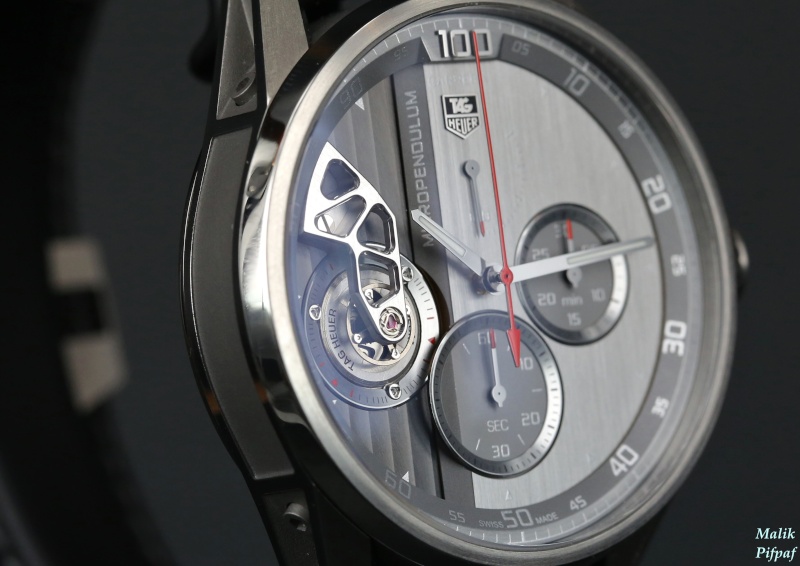
Anyway, in a mechanical watch, magnetism, such as water, was evil incarnated. Until the arrival of the Pendulum by Tag Heuer.
This design watch introduced in 2010 proposed a technical revolution never seen before: the disappearance of the balance-spring in favour of a double pair of magnets generating a pendulum effect through the attraction/repulsion of opposed magnetic poles. You remember magnets, which repelled each other from your childhood? It is this phenomenon at work in the Pendulum. The aim is to replace the mechanic torque of the balance-spring by the Pendulum’s magnetic torque.
Before continuing the explanation, it is advisable to review the Seiko Spring-Drive compared to the Mikropendulum system. As you are aware, Seiko is one of the watchmaking partners of the La Chaux-de-Fonds brand, particularly through the assortments and centring supply.
This could cause confusion. However, there is no link between the Spring-Drive and the Pendulum.
The Spring-Drive is a mechanical watch regulated by quartz commanding a magnetic brake.
The Mikropendulum is a pure mechanical watch, without quartz, of which the balance-spring is uniquely, drove by the interaction of magnets.
Besides, the MikroPendulum movement construction is very classic; apart from the absence of the balance-spring, the rest resembles what we know and love in a mechanical watch.
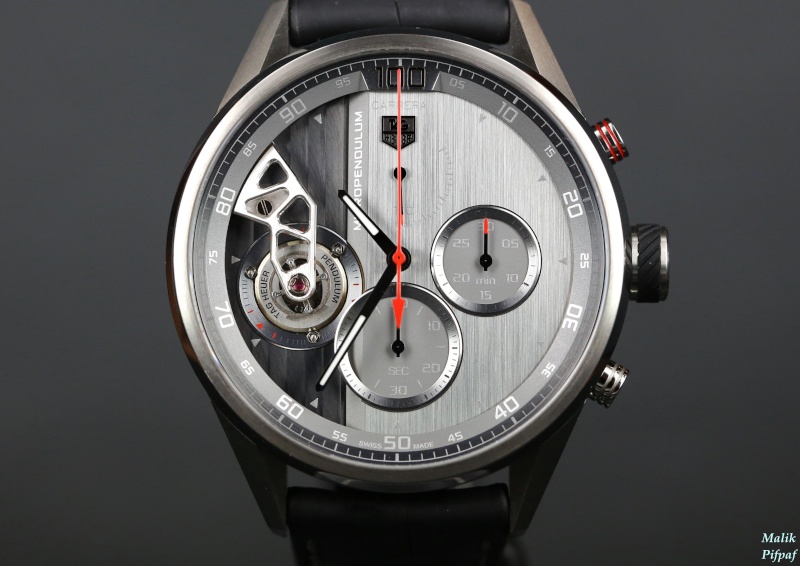
A Pendulum is equipped with a classical balance. On the other hand, below the latter is a balance-spring point. You need to search at the level of the plate, which is situated at the foot of the balance’s rod, plate which is linked to the pallets.
This is no ordinary plate: it is equipped with two magnets each occupying 180° of the plate; one is positive whereas the other is negative. Here and there of the plate, there is a ring which includes two other magnets (each occupying 90° of the circumference, there are two 90° neutral zones), once again a positive and a negative.
The principle is finally very simple, of a great fluidity and on top of that enables the slight diminishing of the frictions… The energy unwinds through the barrel in a classical way but the magnetic forces, which are opposed in the magnets, will regulate this energy instead of the balance-spring’s elasticity phenomenon.
Before looking into the problematic that this may generate, it is appropriate to ask oneself about the added value?
The classical balance-spring has a maximum precision of +/-1 second per day. This limitation is due to manufacturing procedures that do not enable going below 0.1 micrometer. This conditions an average precision of approximately 0.99 second per day, at best (great diffusion calibers are generally very precise, thanks to the super industrialization of the escapement unit’s manufacturing process).
To extend the relatively vague boundaries of precision in a mechanical watch, a new type of regulating organ is thus needed; which uniquely calls on mechanical principles, else it would be called the Spring Drive… Silicon is a solution because the manufacturing margin is even lesser than the one of the Elinvar and company balance-springs. However, if silicon is an innovation in terms of material, it does not question the balance-spring’s principle. Besides, in this environment, silicon is potentially more fragile than the Elinvar.
Anyway, this material is not segmenting enough to create a true technical revolution. This may be considered as an answer to the subject dedicated to the use of silicon in horology…
The Pendulum (named in tribute to a Huygens pendulum, modern horology theorist at the 17th Century) enables extending some boundaries of traditional mechanical horology, as much in terms of precision as shock resistance, or even, to some extent, resistance to magnetic fields.
During its presentation in 2010, it was regulated at 6Hz and while it was functional (which is rare enough in the dream watches world to be pointed out), its stability was not ensured.
Thus, the MikroPendulum will demonstrate that henceforth this magnetic regulation functions.
This watch takes up the aesthetics and even a share of the technology implemented in the Mikros series. Here, reference is obviously being made to a modern Carrera case, inspired by the 60s. The watch is in grade 5 titanium and measures 45mm; the case presents a quite successful alternation of polished and sanded surfaces, which is difficult to concretize on such a hard variety of titanium. If the finish is perfect, one can ask how a more streamlined and more vintage Carrera case from the 60s would be depicted on this model…
On the level of the dial, it is the MikroTourbillonS style which is taken up, in however a colder aspect: while the latter was two-toned, the MikroPendulum presents a grey on anthracite with an ash-coated point. It is cutting-edge technology, it is serious.
The finishes are at the level of the MikroTourbillonS, thus excellent, but one must not expect classical Haute Horlogerie (of the Parmigiani, Lange type), no engaging angles, no subtly sprinkled dial or rural engravings, despite the beautiful finishes (CF the tourbillon bridges), it is cutting-edge technology, one is not here for fun, the Swiss classicism does not at all reign in this watch.
The pit between the brushed side of the dial and the side consisting of the Côtes de Genève is very successful. The latter are evidently an allusion to the numerous vintage Carrera dials and their Geneva waves.
The power reserve is displayed at the 12 o’clock position, the second’s totalizer at the 6 o’clock position (because the chronograph hand makes one turn of the dial per second).
The major innovation concerns the movement. While the watch takes up the Carrera case in the MikroTourbillonS version, it uses the Mikrograph’s architecture adorned with a high-speed magnetic regulating organ.
Remember the Mikrograph, a magnificent special version which had been sold at the 2011 Only Watch and which had had an article dedicated to it.
This base movement consists of two escapements, one traditional with an Elinvar balance-spring, with 28800 vibrations per hour (4Hz) for the hour/minute/second. Added to that, another Pendulum regulating organ, thus a magnetic regulator of 50Hz for the chronograph (that is 360.000 vibrations per hour). The chronograph hand thus makes a turn of the dial per second, which is very very fast. The railway is equipped with 100 graduations, to give the hundredth of a second. A classical chronograph seems totally torpid and outdated when you have had the chance to play with a Mikros… I have a preference for the 1/100, because if it is not the fastest frequency developed by Tag, it is the one presenting the best visibility/speed compromise.
If you are ever lucky enough to hold the watch in your hand, observe the Pendulum balance (thus the one visible at the 9 o’clock position at the dial side), there is a very slight inertia time at the moment the watch stops. Really bluffing.
When one sees watches all year long, one becomes a bit jaded, which is regrettable; but the « Mikros » series is the type of technical slap which immediately puts one back on the right track of horology passion.
The automatic movement measures 15 lignes ¾, that is, 35.8mm for 9.79 mm in width. It is thus a big calibre of which the important thickness has not been well managed: the watch does not seem any thicker than the average. It is obviously a complex watch, with 371 components and 58 rubies. The Pendulum with a frequency of 50Hz owns 90 minutes of power reserve, which is normally enough in everyday use. The HMS movement turns at 4Hz for 42 hours’ use. The unique system of energy regulation enables the COSC certification of the watch side as well as the chronograph side; for the moment, only Tag Heuer owns a technology level necessary to the COSC certification of a functioning chronograph.
What is surprising with this watch is that such an important innovation has not been manufactured by a visionary watchmaker, working for an independent firm and developing his work in a lost barn at the depth of a bucolic valley. No, here it is a great brand supposed to be conservative, even unadventurous just like its colleagues, which is presenting such an innovation!
What it is more impressive but ultimately logical, given Tag Heuer’s reasonable tariff positioning, is the price. The MikroPendulum is sold at 35’000 CHF, the price of a sports chronograph of Haute Horlogerie (it is common knowledge that this notion is very vague). Tag has the impudence to propose a product with an analogue finish level, but with an embedded technology making numerous recent innovations obsolete…

Whereas during the MikroTourbillonS essay, I knew that the elitist tariff did not even allow me to dream buying it, here, at the announcement of the price, I immediately called my banker to create a MikroPendulum-savings account.
At a deeper level, it is a watch that is fully successful where the 1969 Calibre 11 was subdued. This time, Tag Heuer gets the award for innovation and the supremacy of this innovation.
Carrera MikroPendulumS concept.
Before examining this design-watch in detail, let’s have a flashback of 2010, when the first design Pendulum rhymed at 6Hz had been presented. You have noted above that the implementation stage of this first prototype has been relatively long (3 years).
If the problematic caused by the first Pendulum introduced in 2010 is examined in detail, one will get close enough to the problematic encountered by the blued steel paleo-balance-springs (18th and 19th Century), namely:
• Resistance to magnetic fields.
• Stability on the thermal amplitude range.
• Torque’s linearity all along the power reserve.
In addition to this classical problematic, another layer of problems linked to the pendulum’s magnets’ materials is further added. Moreover, contrary to traditional horology, it is almost-impossible to mask an average quality of alloys through an excellent pairing and regulating work.
The problematic is so new and so far-off hammer blows that one had to go to the atom’s heart to develop the MikroPendulum.
For the amateurs, the ferromagnetic used is of the «hard» type; meaning that they are strongly charged with energy, presenting a great stability in time and have to yield to an electromagnetic charge at least equivalent to the one laid up during the manufacturing to be neutralized.
The alloy of magnets constitutes Cobalt, Samarium and Gadolinium (these two last materials are referred to as «rare earth»).
The Samarium-Cobalt complex is well-known in the magnetism world. It is currently the alloy enabling obtaining the highest resistance to magnetic fields. It is used in all fields: IT, military, aeronautics as well as, in a more astonishing way, in the medical field: pacemaker projects consisting of Co-Sm magnets exist.
The Co-Sm alloy thus enables solving the major problematic of the parasitic magnetism; it may be referred to as the equivalent of the Invar for the classical balance-springs. However, as it is, the temperature alterations pitfall determines a precision of +/- 45 seconds per day…

To counter the thermal amplitude effects, one had to add another element, which was much more specific: the Gadolinium. During a rise in temperature, while the materials were expanding, the magnetic fields tend to increase their influence zone. As the magnetism effect is exponential as one gets closer to the source, the expansion effect is disastrous on the isochronism. It is at this moment that the Gadolinium intervenes: this metal has the propriety of being an atomic «sponge»; it absorbs the surplus of particles generated by other chemical elements and thus enables the neutralization of the thermal amplitude effects.
To solve the linearity problems of the torque, the Co-Sa-Gd magnets have been subject to a more watchmaking-oriented work, with a regulation of the elements’ geometry.
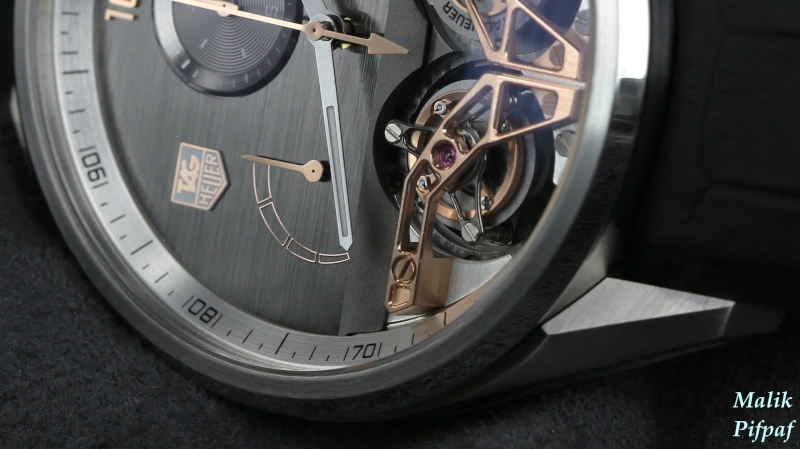
With the solution to this problem found, the Pendulum’s « v1.0 » enables obtaining a precision of +-1/sec per day, the best which can be obtained with an Elinvar balance-spring.
It is necessary to understand that it is a « v1.0 » and that with the feedbacks of the alloys’ (the Gadolinium proportion in particular) refinement experience and the improvement of the geometry, the system should improve in precision in the coming years.
This is so as the Tag Heuer research is characterized by a permanent laboratory aspect, a prototype chasses another prototype and the last innovation is immediately integrated in a commercial watch… All this happened very very quickly: we thus went from a MikroGirder of 1/2000 seconds during the 2012 SIHH to a MikroGirder at 1/10.000th of a second at BaselWorld 2012, that is, a multiplication by five in three months’ time.
Which naturally brings us to the latest Tag Heuer prototype, the MikroPendulumS. It is basically a MikroTourbillonS (described in this article LINK), with the Pendulums instead of the balance-springs.
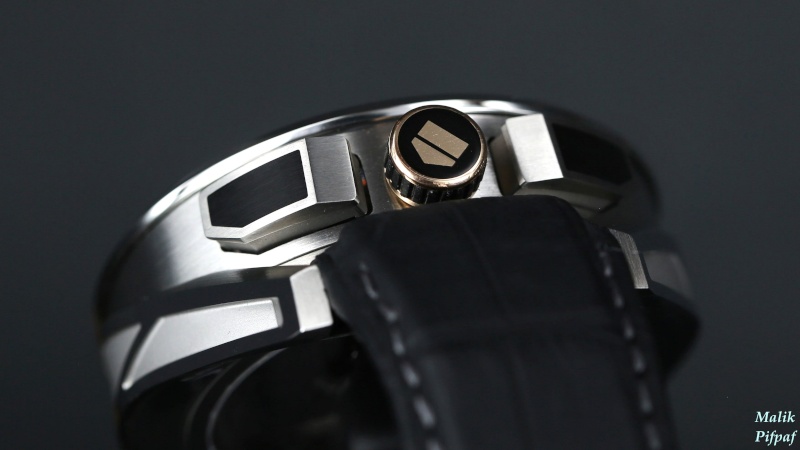
On the visual level, the MikroPendulumS brings three major modifications with regards to the MikroTourbillonS. The abandoning of the Côtes de Genève for brushing like the ones found on the MikroGirder, a 90° movement rotation and a modification of the tourbillon bridges, the indications and functions keeping the status-quo. This implies a « Bullhead » configuration of the push-pieces, which can be found at the 11, 12 and 1 o’clock positions. This year, this configuration has obviously been reviewed on the Jack Heuer. The MikrotourbillonS or the Mikropendulum (without the « S ») configuration, seems more harmonious and is more consistent with the Carrera history.
However, the main question is the technique; and here, just like with the advent of a new prototype, the Tag Heuer laboratory extends the boundaries of the possible.
If henceforth the case’s design is known, the same cannot be said of its material. Here, reference is being made to a Chrome-Cobalt alloy, usually used in «aeronautics», for the turbines’ blades. The volumic mass of the Cr-Co is equivalent to that of steel and bronze, that is, slightly less than 9 times water’s mass.

If there is no significant mass gain, the gain is made on the proprieties’ side: this alloy is more resistant to all types of constraints, more lasting and harder, 530 Vickers, that is the double of the majority of steel alloys used in horology.
The Cr-Cro is manufactured by laser sintering, which is the industrial technique from which the 3D printers are inspired: a powder is fused layer by layer at 1300°C, which enables obtaining finish shapes and levels inaccessible to the traditional CNC… Will this open the door to new possibilities in the movement outlines field?
For the time being, the metals used in the automatic movement of the MikropendulumS are more common. However, it is not the case for its architecture. The calibre measures 15 ¾ (that is, 35.8mm), for 9.84mm in width; it is composed of 454 pieces and 75 rubies.
The escapement unit reserved to time count is equipped with a Pendulum tourbillon of 12Hz (that is, 86400 vibrations per hour) for a 24-hour power reserve (the more the frequency is high, the more the autonomy diminishes) and its frame makes 3 turns per minute (thus it is a 20 seconds tourbillon).
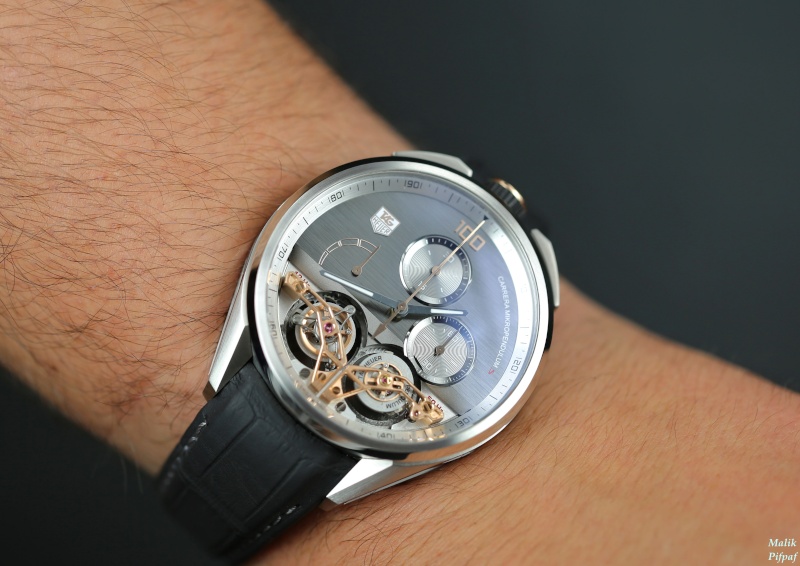
The escapement unit reserved for the chronograph is a Pendulum tourbillon of 50Hz (360000 vibrations per hour) and its tourbillon frame makes 12 rotations per minute (it is thus a 5-seconds tourbillon) for a 60-minutes power reserve (it is less than the Mikropendulum, a tourbillon consumes a lot of energy).
Like the MikrotourbillonS, the MikropendulumS tourbillon chronograph launching is remarkable, it goes like a ground-to-ground missile, or rather like a sports car equipped with an integral transmission and of the launch control. It goes right down, immediately and very quickly. Once again, the MikrotourbillonS is slightly more demonstrative. In any case, we are in a post –horology field.
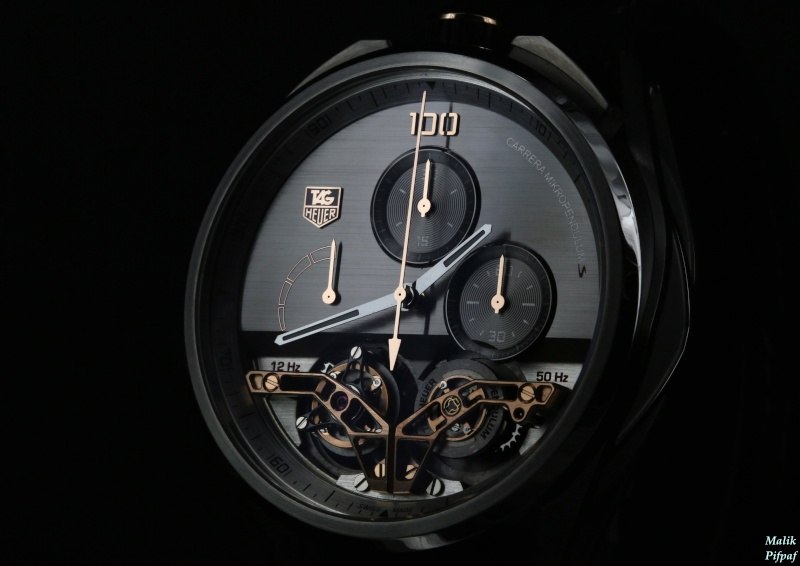
Conclusion:
Initially, the Carrera, sports chronograph, was barely derived from classical watches of the 50s. This Swiss style of the 50s, functionalist-but-elegant, was still influenced by the 30s’ modern art; Swiss people, with their proverbial precaution, are often lagging behind on trends.
Thus, the first Carreras were streamlined; however, in the course of the 60s, these chronographs will rapidly run wild, integrating more and more exotic movements following display needs. Indeed, one of the particularities of the Carrera series is indeed to have adapted displays and movements to the needs of the final users.
Thus, instead of just producing railways or bezels dedicated to a specific usage, Heuer has often reviewed the whole mechanics to better adapt to needs.
To that effect, Heuer’s quest was to adapt the tool to one need, rather than asking the human to adapt themselves to one tool. Nowadays, it would be termed as « user-friendly ».
The dials equally benefitted from a great variety of finishes and styles, always in view of adapting oneself to the final users’ needs. However, it is also in the will to adapt oneself to another human need: the taste of beauty.
This aesthetic will is also found in the cases; the first case of the 60s unquestionably remains the purest: at the time when one knew how to make cases, which appeared very fine while the movements were relatively thick. Later on, aesthetics was given privilege over fashion; today, solidity is privileged…
The Carrera history is so rich and complex that it merits a book. These watches consist of an almost-exhaustive catalogue of mechanical sports timing in these past 50 years. Thus, obviously, this history is a bit chaotic and the connecting thread is not as evident as it is for other mythical watches. But this chaotic aspect is what precisely constitutes the Carrera range richness, an original soup, an Amazonian forest, a horology culture medium, the founding watchmaking chaos.
Despite the purchases, the hand changes and even the integration in a big luxury group, the successive CEOs of Heuer, then TAG Heuer, have continued to believe in innovation and even daily applying the TAG from the 80s: Technique d’Avant-Garde.
The current team, directed for a long time by Jean-Claude Babin (recently replaced by Stéphane Linder) needs a special acclaim since it has had the courage to give carte blanche to the team directed by Guy Sémon to maintain a high innovative level.
It is in no way easy for a great horology brand to maintain a high level of research and development. Inertia and feebleness are colossal in the great watchmaking firms; they prefer investing enormous amounts of money in institutional communication rather than giving money to the laboratory. And even if the R&D services are well equipped, the innovations end up in a drawer, the industrial will for risk-taking being absent.
On the one hand, this can be explained, as you know, by the Heuer innovation tradition, but equally by the bureaucratic structure of Tag Heuer: the firm is directed like an SME, the administrative, commercial and marketing departments all in all count approximately 50 collaborators. As a contrast, the R&D department consists of 45 persons and there are millions of employees in the various manufacturing subsidiaries which manufacture watches…
Eventually, this creativity is reflected in patents about high frequency: today the La Chaux-de-Fonds brand has got a head start by introducing various major advances in the space of a handful of years. This constitutes a historical revenge for Heuer since in its days, the Calibre 11 had progressively been distanced by its competitors.
Today, the Mikropendulum distances the competition in a flash, while having the cheek to be sold at an ultra-aggressive tariff with regard to its exceptional mechanics. Quite like the Muscle Cars design .
If the Carrera’s 50 years assessment is made, the bet initially launched by Jack Heuer has incontestably won.
Jack Heuer transcends the Helvetic neo-classicism of the 50s to introduce functionalism into the chronograph. The reason behind this decision? Mechanical sports.
The connivances between mechanical sports and Tag Heuer are old and intimately linked to the La Chaux-de-Fonds’ brand history. This adventure began before the Great War. In 1963, Tag had already been manufacturing pocket watches dedicated to sports timing for more than fifty years. For instance, the “Mikrographe” vintage was manufactured at the start of the 20th Century or, some years before the Carrera, the “Rally Master”, a dashboard chronograph.
As an opposition to what the neophyte may presume, the Carrera name is not linked to Porsche; it was rather inspired by the mythical race of the 50s, the Carrera Panamericana AKA “Pan Am”. What can be seen as an astonishing paradox is that before 1963, this event had not occurred since 1955, following a decision of Mexican authorities. This interruption was the result of the psychological trauma caused by the tragic accident of the Mercedes 300 SLR at the 24H of the Mans 1955… However, Jack Heuer turned out to be a visionary by betting on the resurrection of this anthology race... The event is back on track since 1988.
It is this vision, this intuition, this understanding which are the forging factors of the Carrera history…
Heuer Carrera 45 Dato "Cobra Shelby" 3147
Likely to be seen as something minor nowadays, one was aware that even the most minor detail was relevant in performance research at the time.
Heuer applied the solutions giving a maximum readability to military watches of the interwar period to sports watches: greater aperture and black dial for a maximum of contrast.
The first reference of the Carrera is the 2447. Bicompax, panda or full black, it is a round watch of 36mm (which was relatively big for the time). Animated by a Valjoux 72, a standard movement during the after-war; its frequency is at 18000 vph for 45 hours of power reserve.

It presents numerous similarities with the Rolex “Pré-Daytona” ref. 6238: the calibre, the dial and the push-pieces. What is even better is that the future 6239, just like the Carrera, will adopt the name of an automobile event across the Atlantic: Daytona.
However, even if the Daytona and the Carrera started off at almost the same point (in the 60s, the products were less “identity-oriented” than today) and were presented in the same year (the Daytona also celebrates its 50 years this year), they had diametrically opposed destinies.
On the one hand, the Daytona evolved very little, as much in terms of motorization as aesthetics, since Rolex privileged reliability and durability above all.
On the other hand, the Carrera became a permanent, aesthetic and technical laboratory.
Here, we have to make reference to the Heuer Carrera 45 Dato « Cobra Shelby » 3147. In fact, in 1963, it was rare to have “branded” watches (the 70s and 80s were the Golden Age of the “branded” watches).
It is thus due to the logo of the British constructor that the 3147 will be of more interest to us than the 2447.
Despite the legitimacy and the explosive potential of a partnership between the AC Cobra and Tag Heuer niche constructor, the Dato 45 was not a commercial watch.
In the 60s, Carol Shelby, ex-racing driver (he won the 24h du Mans in 1959 Mans with Aston Martin), decided to create the American racing car; he turned to Ford, which was able to supply the motor and the money and was helped by AC, a British constructor which owned the European know-how in terms of chassis.

The AC Cobra was born; it would know a qualified success: sales during the 60s did not exceed 1000 copies, divided into diverse versions.
The car is too early and too pointed, it precedes the Muscle Cars era; however, the latter will aim higher in the objective set by the Cobra Shelby: be as powerful as the GTs of the moment for much less money.
Shelby had opted for a compromise between the dynamic qualities of the automobile and its cost. The Muscle Cars would be much more radical, leaving behind all equilibrium in terms of behavior, in favor of atmospherics V8s under steroids, at dumped prices…
To motivate sales forces, the Ford group asked Jack Heuer to manufacture its Dato 45, declined into two series : the first (1966-67), Bicompax and the second (1968-69) more radical, Monocompax, the latter consisting of the AC Cobra initials.

It is obviously this version which will be of interest here since it prefigures various heavy trends through its aesthetics. First and foremost, the automobile/horology partners which are henceforth the forgotten passage of any large-scale watchmaking firm.
The dial is decorated with an automobile brand’s logo (a first?!) And what a logo! AC’s Cobra is incredibly aggressive and perfectly corresponds to Shelby’s sports vocation: combine the best of European and American automobile.
Then, the watch proposes a big date and a big white timer of graduated minutes up to 45. Obviously, everything is done in the scope of a maximum readability: with its great aperture at the dial, the watch cuts more than the announced 36mm.
The case is the embodiment of simplicity; its horns are very long which is logical given its size. Besides, the current Carreras will conserve this characteristic but with a greater-sized case.
Furthermore, the watch is motored by an unusual caliber (in the Carreras only; it was relatively common at the time) of manual chronograph: the Landeron 189, 31mm in diameter for 6.85mm in width. It has a frequency of 18000 vibrations per hour for 42 hours of power reserve.

It is to be noted that the steel case resonates quite a lot and that the sound characteristic of 2.5Hz is quite audible for such a small watch.
If the Heuer Carrera 45 Dato “Cobra Shelby” is almost impossible to find by chance, you may find a 45 Dato without logo for approximately 3’500 CHF…
Which is much less expensive than an original Cobra Shelby, because let’s admit it, it is much more simple (and economic!) to wear a vintage watch than to drive an appropriate car.
Heuer Skipper 7754 « Skipperera »
Another model which is slightly off-beat but very much iconic of the creative medium that defines this series is the Skipperera. The Skippers are a bit difficult to classify in the Heuer lines, as they are sometimes Autavia and sometimes Carrera. Experts air varying opinions about it…

As far as the aptly named “Skiperrera” presents a Carrera case, one can consider that it is a full Carrera.
The interest of this watch lies in its aesthetics. It neither distinguishes itself by its case, which is the standard version of the Carreras, neither by its calibre, a Valjoux 7730.
However, before focusing on the dial, it is useful to linger on this calibre a bit. The Valjoux 7730 is a calibre of manual chronograph having a frequency of 18000 vibrations per hour for 45 hours of power reserve, it measures 31mm on 6, that is, almost the same dimensions as the Landeron 189.

One will note that at the time, the size ratio of the caliber/size of the case was different from that of today. Back then, like sports cars’ motors, big calibers were cased up in small cases, at shoehorn.
What makes the particularity of this 7730 (which is probably the reason for his choosing this Skipper) is that it offered the possibility to display 30 or 45 minutes on the sub-dial at the 3 o’clock position. And here, Heuer had driven this function into a corner: by modifying a wheel, it was possible to display only 15 minutes by thirty jumps of thirty seconds.
Why is that? The answer is, as always, that it was for this famous countdown of the regatta launching. One will equally note that the minutes’ timer is graduated in the inverted direction: it is launched 15 minutes before the regattas start, the last third indicating the “warm-up” of the event.

However, the main interest of the watch does not concern the above but rather the dial, which is one of the most beautiful that I have ever held. The dials from that epoch are of a great quality and are no less appealing than the current productions. The reliefs are qualitative, the textures very clean and above all they grow old in a very good way, of which the good quality of the epoch’s lacquer is proof.
The colour scheme of this Carrera 7754 is perfect: night blue, almond green, orange, in ideal proportions. In a visionary way, it synthesises everything that was best made in sports and summer dials of the next 40 years. Night blue for looking good, orange for relaxation and almond green for nostalgia.
Moreover, the very streamlined context of the Carrera (white railroad, index and simple hands) further highlights the colour scheme.
The collectors are not wrong; it is approximately quoted the double of a Carrera from that time, often as from 7’000 CHF.

Heuer Carrera « Automatic 70’ » 110.253, Côte de Genève
Directly moving on to the year 1978, we will interest ourselves with the Heuer Carrera 110.253 since the latter joins numerous emblematic elements of the 70s’ Carrera.
The first major change was the case: it became barrel, was enlarged by 2mm and lost its long horns, very characteristic of the 70s. For the purists, it is undoubtedly slightly shocking; so much as this model distanced itself from the 60s’ models. However, in opposition to a Daytona, which is monolithic by vocation, it is a laboratory; it is thus legitimate that its creators attempted to change the shape of its case.

From a personal point of view, I prefer the 60s’ case due to the fact that its streamlining seems completely achieved to me. Here, the case is very sympathetic, very funky but slightly clumsier than the one from the 60s. While the 60s’ case was the avatar of Jack Heuer’s modernism passion, the 70s’ case ensued from a simplification wish of a case already very streamlined, of postmodernism all in all… Consequently, the case called “automatic 70’” has two advantages: its more solid horns and its superior diameter; as a result, these Carreras seem much bigger on the wrist than their predecessors.
It seems that Tag Heuer has made the same choice for its contemporary watches, in preserving the 60s’ case shape (this will further be developed at the end of the article).
If the case has been named «Automatic 70’», it must be known that a good deal of the watches it equips are manual!
In fact, the 70s are the time at which automatic chronographs appeared right in the middle of the quartz crisis… Between financial and suppliers problems, reliability issues of the automatic chronographs, a great deal of the Carreras from the 70s were equipped with manual movement.

However, this is not the case for this 110.253, which is equipped with a variant of the legendary Heuer Buren Calibre 11: the vintage calibre 12.
The calibre 12 is thus an automatic chronograph with 21600 vibrations per hour, contrary to the vintage calibre 11, with an intermediary frequency of 19800 vibrations per hour. The caliber has a 42-hour power reserve and measures 31mm for 7.7 in width.
It has been nicknamed «Chronomatic» and the oscillating mass will not be visible on the photos: which is normal since it has been hidden by the chronograph’s mechanism.
Like the Calibre 11, the vintage calibre 12 is a Buren 1281 with a Dubois Depraz 8510 chronograph module.
Nevertheless, if it is more classic in its frequency, it is also more legitimate: a six jumps per seconds basis is the most legitimate in a sexagesimal time system.

Last detail, the crown has been fitted at the 9 o’clock position but the push-buttons (less protruding than that of the 60s’ models, alas) are in their usual position, namely at the right of the case. The contrary might have been more ergonomic, it seems more instinctive to activate a chronograph with the right hand’s thumb rather than with the index…
On the dial’s side, like the other vintage Carreras, it is sportive classicism with a touch of madness, the whole served by an execution level which is no less appealing than the most beautiful current productions.
Proof of this? The dial is crossed by three big blue Côtes de Genève, very well made, the black sub counters almost break its harmony. In fact, the latters are flat and matt with white indexes. However, despite the beauty of its dial, this Carrera 110.253 is a tool watch, thus the functional aspect prevails.
Besides, the whole of the index/hands remains very classic, polished steel, streamlined design. Priority is given to efficiency.
It is not very hard to find one at approximately 2’500 CHF, which isn’t much if the dial’s execution quality and the embedded legendary movement are taken into consideration.

Heuer Carrera « Automatic » 510.511, military aviation.
Just like the Skipperera, the 510.511 is a rarity, outside the Carrera series. So why is this piece being described?
Contrary to the Skipperera, it is not the most beautiful of the Carreras, but its technical interest is enormous.
As an introduction, it is worth knowing that this watch has a false twin, the 510.513, identical with a dial presenting blue Côtes de Genève arranged horizontally. Unfortunately, this piece was not available at the Tag Heuer museum where the photos of this reporting have been taken.

The watch exists in two versions: one in steel (ref 510.523), and one in PVD steel, this latter finish reinforcing its military aspect. The case takes up the design of the « Automatics 70’ » (even if the watch dates from 1984), but it is slightly bigger, with 40mm in diameter. The watch is water resistant to 100 meters and the push-pieces are of the right size.
This watch’s interest resides in its caliber: back then, Lemania was not in the Swatch Group circle (Lemania’s industrial tool served to build the Breguet firm) and produced numerous watches and calibers to the destination of armed forces.
Thus, the legendary Lemania 5100 which equips this Carrera 510.511 is an automatic chronograph mechanism of second generation intended for military aviation, including fighter pilots. It is why this movement presents an extraordinary resistance to the accelerating forces (11G) and to strong decelerations (7G).
It may be used for several years without service and is exceptionally robust. Its construction is unusual, the movement is structured around pillars, like a building and has some nylon pieces (which was trendy at the time…)

It has a frequency of 28800 vibrations per hour for 48 hours of power reserve and measures 31mm for 8.2, thus slightly bigger than a 7750.
Many wrote that it is not very beautiful. It is certainly not the incarnation of sex-appeal, but apart from the El Primero (Calibre 36 at Tag Heuer), the automatic chronographs’ movements from the years 70-80 were much less beautiful than the manual chronographs’ calibers of the after-war.
Moreover, this movement has several functions. The most noteworthy and playful is the central minutes’ timer, materialized by the aeroplane-shaped orange hand. The watch has four hands which pass through the central cannon: hour, minute, chrono second and chrono minute.
In addition to the 60 seconds and minutes at the center, the chronograph indicates the twelve hours cumulated at the 6 o’clock position, the 24h time at the 12 o’clock position, the small second at the 9 o’clock position and finally the date at the 3 o’clock position. Even if it is relatively charged, it is no less readable.
A relatively rare and totally mythical watch, which can be found at approximately 3’500 CHF, which is completely correct given the product’s quality. I cannot advise strongly enough the 510.513 if you bear it an interest, less military-aviation in its look and more Funky-Carrera.
Tag Heuer Carrera Calibre 36 ref: CAR2B11.BA0799
Beware, we are focusing on BaselWorld 2013 without transition since the Carrera series still exists and innovation remains present in this mythical model’s 50th anniversary year. You will find that at each generation, the references become more complex… By making an almost 30-year jump (including a long ten-year interruption, from the mid-80s to 1996), the 6-number reference has been transformed into this type of reference: CAR2B11.BA0799. Phew.
Before getting into the details of this Calibre 36, which particularly seduced me, two other models deserve a special mention on the occasion of this anniversary year.

It is thus obviously, the anniversary model, the Jack Heuer Carrera declined into two versions, which correspond to two founding decades of the Carrera series.
The first model is thus the Jack Heuer Calibre 17, 80th anniversary (Jack Heuer’s) which is the direct descendant of the 2446 evoked at the start of this article, 41mmsteel, Calibre 17, it even takes up the panda dial! Consequently, it virtually resembles the first Carrera, in a more modern format. Perennially fashionable, efficient.
The second model is the Jack Heuer calibre 1887, in the Bull-head format! This layout results from a 90° rotation, where the push-pieces are at the 11 and 1 o’clock positions and the crown at the 12 o’clock position.

It is the most emblematic chronograph configuration of the 70s, directly inspired from the Stopwatches (Heuer in particular) buttons’ layout, typical of Olympic stadiums as well as 70s’ EPS courses!
Surprisingly, against all expectations, there was no Heuer Carrera with this type of configuration at the time. It almost seems like Heuer wants to make up for this oversight by introducing such an emblematic watch. The case measures 45mm in diameter, it is in steel and DLC titanium at the level of the bezel, and is equipped with the calibre 1887. This watch deserves a long review, so that its historical, technical and cultural aspects may be examined…

Back to the Calibre 36, it is equipped with a bi-coloured dial and this watch is exciting at several levels. It is a synthetic watch of the trends which have passed at Tag.
Before embarking upon the analysis of its aesthetics, the focus needs to be put on its motor. The watch is equipped with a Calibre 36, that is, a Zenith El Primero modified for Tag Heuer.
Today, Zenith and Tag Heuer work together in the midst of the LMVH group. However, this has not always been the case: at the end of the 60s, these brands had launched themselves in a technological course, to know which would first introduce an automatic chronograph.
Without any suspense, with its longevity as proof, the El Primero hit two birds with one stone: on the one hand, it had been introduced some weeks before the 1969 Calibre 11; but it had above all turned out to be a better solution in terms of frequency, reliability and even aesthetics: it was the most beautiful automatic chronograph caliber from that time.

No one is perfect, the central timers are too close to one another and due to its high frequency the power reserve is often slightly short according to the type of barrel spring that the EP embeds…
In this recent version, Tag Heuer has nevertheless done the necessary modification work: the 36-hour power reserve has been increased to 50 hours, which is sufficient to set the watch down for the week-end. As a reminder, the EP/Calibre 36 is rhymed at 5Hz/36000 vibrations per hour, measures 30mm in diameter and is fitted with 31 rubies.

Likewise, a trick has been employed to propose an aesthetic giving sense to the too close sub-timers. This Calibre 36 of 43mm in diameter takes up the aesthetics of the vintage stopwatches, pocket watches above all intended for sports timing. The big railway justifies the sub-timers drawn together.
Obviously, we had already seen this dial with the outdated charm on the Mikrograph and Mikrogirder of 2011-2012; besides, one of the watch’s forces was to make a mechanism stemming from aerospace cohabit with neo-classical external parts.

Here, owing to cost issues, the mechanism is evidently less innovative. However, the calibre 36 is nevertheless very beautiful and is in accordance with this two-toned dial. Moreover, it is one of the most qualitative watches introduced by Tag Heuer: the white lacquer does not excessively shine; the central grey satiny gives discreet but warm reflections off and the hands/index whole is in conformity with the vintage Carreras.
The latters’ case is less heavy than the 43mm in diameter one, but the watch is not too large according to the current criteria.
It is to be noted that this CAR2B11.BA0799 has elicited unanimity with the profession, almost all of our journalist and blogger colleagues having succumbed to this piece’s charm… Its price is in the average range of the market for equivalent products, that is, approximately 8000CHF.
Carrera MikroPendulum.
You got it, the Carrera watches are a dynamic history made of innovations and research. Yet, in these past years, Tag Heuer has been the most innovating mass brand, very much ahead its direct competitors…
The innovations are centered around two principal axes: the very high frequency (more than 5Hz) and magnetism. It is advisable to remember that, as per the rules of quantum mechanics, magnetism is one of the four forces which govern the universe, the others being the strong interaction (which maintains atoms’ cohesion), weak interaction (initiating radioactivity) and gravitation.
Electromagnetism is particularly the force which animates the photons, the one which is the daily light provider and harvest grower… Additionally, it also maintains the shopping list on the refrigerator .
In short, this major force of the universe has paradoxically always been disputed by the watchmakers, which have tried everything, with a certain success margin, to discard horology movements from it (non-magnetic watches, low-magnetic watches, etc.), the most critical point being the escapement unit. The vintage balance-springs were very sensitve to magnetic fields and even today, magnetic balance-springs are a frequent cause of after-sales service return.

Anyway, in a mechanical watch, magnetism, such as water, was evil incarnated. Until the arrival of the Pendulum by Tag Heuer.
This design watch introduced in 2010 proposed a technical revolution never seen before: the disappearance of the balance-spring in favour of a double pair of magnets generating a pendulum effect through the attraction/repulsion of opposed magnetic poles. You remember magnets, which repelled each other from your childhood? It is this phenomenon at work in the Pendulum. The aim is to replace the mechanic torque of the balance-spring by the Pendulum’s magnetic torque.
Before continuing the explanation, it is advisable to review the Seiko Spring-Drive compared to the Mikropendulum system. As you are aware, Seiko is one of the watchmaking partners of the La Chaux-de-Fonds brand, particularly through the assortments and centring supply.
This could cause confusion. However, there is no link between the Spring-Drive and the Pendulum.
The Spring-Drive is a mechanical watch regulated by quartz commanding a magnetic brake.
The Mikropendulum is a pure mechanical watch, without quartz, of which the balance-spring is uniquely, drove by the interaction of magnets.
Besides, the MikroPendulum movement construction is very classic; apart from the absence of the balance-spring, the rest resembles what we know and love in a mechanical watch.

A Pendulum is equipped with a classical balance. On the other hand, below the latter is a balance-spring point. You need to search at the level of the plate, which is situated at the foot of the balance’s rod, plate which is linked to the pallets.
This is no ordinary plate: it is equipped with two magnets each occupying 180° of the plate; one is positive whereas the other is negative. Here and there of the plate, there is a ring which includes two other magnets (each occupying 90° of the circumference, there are two 90° neutral zones), once again a positive and a negative.
The principle is finally very simple, of a great fluidity and on top of that enables the slight diminishing of the frictions… The energy unwinds through the barrel in a classical way but the magnetic forces, which are opposed in the magnets, will regulate this energy instead of the balance-spring’s elasticity phenomenon.
Before looking into the problematic that this may generate, it is appropriate to ask oneself about the added value?
The classical balance-spring has a maximum precision of +/-1 second per day. This limitation is due to manufacturing procedures that do not enable going below 0.1 micrometer. This conditions an average precision of approximately 0.99 second per day, at best (great diffusion calibers are generally very precise, thanks to the super industrialization of the escapement unit’s manufacturing process).
To extend the relatively vague boundaries of precision in a mechanical watch, a new type of regulating organ is thus needed; which uniquely calls on mechanical principles, else it would be called the Spring Drive… Silicon is a solution because the manufacturing margin is even lesser than the one of the Elinvar and company balance-springs. However, if silicon is an innovation in terms of material, it does not question the balance-spring’s principle. Besides, in this environment, silicon is potentially more fragile than the Elinvar.
Anyway, this material is not segmenting enough to create a true technical revolution. This may be considered as an answer to the subject dedicated to the use of silicon in horology…
The Pendulum (named in tribute to a Huygens pendulum, modern horology theorist at the 17th Century) enables extending some boundaries of traditional mechanical horology, as much in terms of precision as shock resistance, or even, to some extent, resistance to magnetic fields.
During its presentation in 2010, it was regulated at 6Hz and while it was functional (which is rare enough in the dream watches world to be pointed out), its stability was not ensured.
Thus, the MikroPendulum will demonstrate that henceforth this magnetic regulation functions.
This watch takes up the aesthetics and even a share of the technology implemented in the Mikros series. Here, reference is obviously being made to a modern Carrera case, inspired by the 60s. The watch is in grade 5 titanium and measures 45mm; the case presents a quite successful alternation of polished and sanded surfaces, which is difficult to concretize on such a hard variety of titanium. If the finish is perfect, one can ask how a more streamlined and more vintage Carrera case from the 60s would be depicted on this model…
On the level of the dial, it is the MikroTourbillonS style which is taken up, in however a colder aspect: while the latter was two-toned, the MikroPendulum presents a grey on anthracite with an ash-coated point. It is cutting-edge technology, it is serious.
The finishes are at the level of the MikroTourbillonS, thus excellent, but one must not expect classical Haute Horlogerie (of the Parmigiani, Lange type), no engaging angles, no subtly sprinkled dial or rural engravings, despite the beautiful finishes (CF the tourbillon bridges), it is cutting-edge technology, one is not here for fun, the Swiss classicism does not at all reign in this watch.
The pit between the brushed side of the dial and the side consisting of the Côtes de Genève is very successful. The latter are evidently an allusion to the numerous vintage Carrera dials and their Geneva waves.
The power reserve is displayed at the 12 o’clock position, the second’s totalizer at the 6 o’clock position (because the chronograph hand makes one turn of the dial per second).
The major innovation concerns the movement. While the watch takes up the Carrera case in the MikroTourbillonS version, it uses the Mikrograph’s architecture adorned with a high-speed magnetic regulating organ.
Remember the Mikrograph, a magnificent special version which had been sold at the 2011 Only Watch and which had had an article dedicated to it.
This base movement consists of two escapements, one traditional with an Elinvar balance-spring, with 28800 vibrations per hour (4Hz) for the hour/minute/second. Added to that, another Pendulum regulating organ, thus a magnetic regulator of 50Hz for the chronograph (that is 360.000 vibrations per hour). The chronograph hand thus makes a turn of the dial per second, which is very very fast. The railway is equipped with 100 graduations, to give the hundredth of a second. A classical chronograph seems totally torpid and outdated when you have had the chance to play with a Mikros… I have a preference for the 1/100, because if it is not the fastest frequency developed by Tag, it is the one presenting the best visibility/speed compromise.
If you are ever lucky enough to hold the watch in your hand, observe the Pendulum balance (thus the one visible at the 9 o’clock position at the dial side), there is a very slight inertia time at the moment the watch stops. Really bluffing.
When one sees watches all year long, one becomes a bit jaded, which is regrettable; but the « Mikros » series is the type of technical slap which immediately puts one back on the right track of horology passion.
The automatic movement measures 15 lignes ¾, that is, 35.8mm for 9.79 mm in width. It is thus a big calibre of which the important thickness has not been well managed: the watch does not seem any thicker than the average. It is obviously a complex watch, with 371 components and 58 rubies. The Pendulum with a frequency of 50Hz owns 90 minutes of power reserve, which is normally enough in everyday use. The HMS movement turns at 4Hz for 42 hours’ use. The unique system of energy regulation enables the COSC certification of the watch side as well as the chronograph side; for the moment, only Tag Heuer owns a technology level necessary to the COSC certification of a functioning chronograph.
What is surprising with this watch is that such an important innovation has not been manufactured by a visionary watchmaker, working for an independent firm and developing his work in a lost barn at the depth of a bucolic valley. No, here it is a great brand supposed to be conservative, even unadventurous just like its colleagues, which is presenting such an innovation!
What it is more impressive but ultimately logical, given Tag Heuer’s reasonable tariff positioning, is the price. The MikroPendulum is sold at 35’000 CHF, the price of a sports chronograph of Haute Horlogerie (it is common knowledge that this notion is very vague). Tag has the impudence to propose a product with an analogue finish level, but with an embedded technology making numerous recent innovations obsolete…

Whereas during the MikroTourbillonS essay, I knew that the elitist tariff did not even allow me to dream buying it, here, at the announcement of the price, I immediately called my banker to create a MikroPendulum-savings account.
At a deeper level, it is a watch that is fully successful where the 1969 Calibre 11 was subdued. This time, Tag Heuer gets the award for innovation and the supremacy of this innovation.
Carrera MikroPendulumS concept.
Before examining this design-watch in detail, let’s have a flashback of 2010, when the first design Pendulum rhymed at 6Hz had been presented. You have noted above that the implementation stage of this first prototype has been relatively long (3 years).
If the problematic caused by the first Pendulum introduced in 2010 is examined in detail, one will get close enough to the problematic encountered by the blued steel paleo-balance-springs (18th and 19th Century), namely:
• Resistance to magnetic fields.
• Stability on the thermal amplitude range.
• Torque’s linearity all along the power reserve.
In addition to this classical problematic, another layer of problems linked to the pendulum’s magnets’ materials is further added. Moreover, contrary to traditional horology, it is almost-impossible to mask an average quality of alloys through an excellent pairing and regulating work.
The problematic is so new and so far-off hammer blows that one had to go to the atom’s heart to develop the MikroPendulum.
For the amateurs, the ferromagnetic used is of the «hard» type; meaning that they are strongly charged with energy, presenting a great stability in time and have to yield to an electromagnetic charge at least equivalent to the one laid up during the manufacturing to be neutralized.
The alloy of magnets constitutes Cobalt, Samarium and Gadolinium (these two last materials are referred to as «rare earth»).
The Samarium-Cobalt complex is well-known in the magnetism world. It is currently the alloy enabling obtaining the highest resistance to magnetic fields. It is used in all fields: IT, military, aeronautics as well as, in a more astonishing way, in the medical field: pacemaker projects consisting of Co-Sm magnets exist.
The Co-Sm alloy thus enables solving the major problematic of the parasitic magnetism; it may be referred to as the equivalent of the Invar for the classical balance-springs. However, as it is, the temperature alterations pitfall determines a precision of +/- 45 seconds per day…

To counter the thermal amplitude effects, one had to add another element, which was much more specific: the Gadolinium. During a rise in temperature, while the materials were expanding, the magnetic fields tend to increase their influence zone. As the magnetism effect is exponential as one gets closer to the source, the expansion effect is disastrous on the isochronism. It is at this moment that the Gadolinium intervenes: this metal has the propriety of being an atomic «sponge»; it absorbs the surplus of particles generated by other chemical elements and thus enables the neutralization of the thermal amplitude effects.
To solve the linearity problems of the torque, the Co-Sa-Gd magnets have been subject to a more watchmaking-oriented work, with a regulation of the elements’ geometry.

With the solution to this problem found, the Pendulum’s « v1.0 » enables obtaining a precision of +-1/sec per day, the best which can be obtained with an Elinvar balance-spring.
It is necessary to understand that it is a « v1.0 » and that with the feedbacks of the alloys’ (the Gadolinium proportion in particular) refinement experience and the improvement of the geometry, the system should improve in precision in the coming years.
This is so as the Tag Heuer research is characterized by a permanent laboratory aspect, a prototype chasses another prototype and the last innovation is immediately integrated in a commercial watch… All this happened very very quickly: we thus went from a MikroGirder of 1/2000 seconds during the 2012 SIHH to a MikroGirder at 1/10.000th of a second at BaselWorld 2012, that is, a multiplication by five in three months’ time.
Which naturally brings us to the latest Tag Heuer prototype, the MikroPendulumS. It is basically a MikroTourbillonS (described in this article LINK), with the Pendulums instead of the balance-springs.

On the visual level, the MikroPendulumS brings three major modifications with regards to the MikroTourbillonS. The abandoning of the Côtes de Genève for brushing like the ones found on the MikroGirder, a 90° movement rotation and a modification of the tourbillon bridges, the indications and functions keeping the status-quo. This implies a « Bullhead » configuration of the push-pieces, which can be found at the 11, 12 and 1 o’clock positions. This year, this configuration has obviously been reviewed on the Jack Heuer. The MikrotourbillonS or the Mikropendulum (without the « S ») configuration, seems more harmonious and is more consistent with the Carrera history.
However, the main question is the technique; and here, just like with the advent of a new prototype, the Tag Heuer laboratory extends the boundaries of the possible.
If henceforth the case’s design is known, the same cannot be said of its material. Here, reference is being made to a Chrome-Cobalt alloy, usually used in «aeronautics», for the turbines’ blades. The volumic mass of the Cr-Co is equivalent to that of steel and bronze, that is, slightly less than 9 times water’s mass.

If there is no significant mass gain, the gain is made on the proprieties’ side: this alloy is more resistant to all types of constraints, more lasting and harder, 530 Vickers, that is the double of the majority of steel alloys used in horology.
The Cr-Cro is manufactured by laser sintering, which is the industrial technique from which the 3D printers are inspired: a powder is fused layer by layer at 1300°C, which enables obtaining finish shapes and levels inaccessible to the traditional CNC… Will this open the door to new possibilities in the movement outlines field?
For the time being, the metals used in the automatic movement of the MikropendulumS are more common. However, it is not the case for its architecture. The calibre measures 15 ¾ (that is, 35.8mm), for 9.84mm in width; it is composed of 454 pieces and 75 rubies.
The escapement unit reserved to time count is equipped with a Pendulum tourbillon of 12Hz (that is, 86400 vibrations per hour) for a 24-hour power reserve (the more the frequency is high, the more the autonomy diminishes) and its frame makes 3 turns per minute (thus it is a 20 seconds tourbillon).

The escapement unit reserved for the chronograph is a Pendulum tourbillon of 50Hz (360000 vibrations per hour) and its tourbillon frame makes 12 rotations per minute (it is thus a 5-seconds tourbillon) for a 60-minutes power reserve (it is less than the Mikropendulum, a tourbillon consumes a lot of energy).
Like the MikrotourbillonS, the MikropendulumS tourbillon chronograph launching is remarkable, it goes like a ground-to-ground missile, or rather like a sports car equipped with an integral transmission and of the launch control. It goes right down, immediately and very quickly. Once again, the MikrotourbillonS is slightly more demonstrative. In any case, we are in a post –horology field.

Conclusion:
Initially, the Carrera, sports chronograph, was barely derived from classical watches of the 50s. This Swiss style of the 50s, functionalist-but-elegant, was still influenced by the 30s’ modern art; Swiss people, with their proverbial precaution, are often lagging behind on trends.
Thus, the first Carreras were streamlined; however, in the course of the 60s, these chronographs will rapidly run wild, integrating more and more exotic movements following display needs. Indeed, one of the particularities of the Carrera series is indeed to have adapted displays and movements to the needs of the final users.
Thus, instead of just producing railways or bezels dedicated to a specific usage, Heuer has often reviewed the whole mechanics to better adapt to needs.
To that effect, Heuer’s quest was to adapt the tool to one need, rather than asking the human to adapt themselves to one tool. Nowadays, it would be termed as « user-friendly ».
The dials equally benefitted from a great variety of finishes and styles, always in view of adapting oneself to the final users’ needs. However, it is also in the will to adapt oneself to another human need: the taste of beauty.
This aesthetic will is also found in the cases; the first case of the 60s unquestionably remains the purest: at the time when one knew how to make cases, which appeared very fine while the movements were relatively thick. Later on, aesthetics was given privilege over fashion; today, solidity is privileged…
The Carrera history is so rich and complex that it merits a book. These watches consist of an almost-exhaustive catalogue of mechanical sports timing in these past 50 years. Thus, obviously, this history is a bit chaotic and the connecting thread is not as evident as it is for other mythical watches. But this chaotic aspect is what precisely constitutes the Carrera range richness, an original soup, an Amazonian forest, a horology culture medium, the founding watchmaking chaos.
Despite the purchases, the hand changes and even the integration in a big luxury group, the successive CEOs of Heuer, then TAG Heuer, have continued to believe in innovation and even daily applying the TAG from the 80s: Technique d’Avant-Garde.
The current team, directed for a long time by Jean-Claude Babin (recently replaced by Stéphane Linder) needs a special acclaim since it has had the courage to give carte blanche to the team directed by Guy Sémon to maintain a high innovative level.
It is in no way easy for a great horology brand to maintain a high level of research and development. Inertia and feebleness are colossal in the great watchmaking firms; they prefer investing enormous amounts of money in institutional communication rather than giving money to the laboratory. And even if the R&D services are well equipped, the innovations end up in a drawer, the industrial will for risk-taking being absent.
On the one hand, this can be explained, as you know, by the Heuer innovation tradition, but equally by the bureaucratic structure of Tag Heuer: the firm is directed like an SME, the administrative, commercial and marketing departments all in all count approximately 50 collaborators. As a contrast, the R&D department consists of 45 persons and there are millions of employees in the various manufacturing subsidiaries which manufacture watches…
Eventually, this creativity is reflected in patents about high frequency: today the La Chaux-de-Fonds brand has got a head start by introducing various major advances in the space of a handful of years. This constitutes a historical revenge for Heuer since in its days, the Calibre 11 had progressively been distanced by its competitors.
Today, the Mikropendulum distances the competition in a flash, while having the cheek to be sold at an ultra-aggressive tariff with regard to its exceptional mechanics. Quite like the Muscle Cars design .
If the Carrera’s 50 years assessment is made, the bet initially launched by Jack Heuer has incontestably won.

